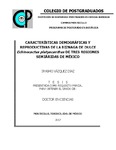| dc.contributor.author | Vázquez Díaz, Erasmo | |
| dc.creator | VÁZQUEZ DÍAZ, ERASMO; 218020 | |
| dc.date.accessioned | 2019-08-27T17:25:44Z | |
| dc.date.available | 2019-08-27T17:25:44Z | |
| dc.date.issued | 2017-11 | |
| dc.identifier.uri | http://hdl.handle.net/10521/3884 | |
| dc.description | Tesis (Doctorado en Ciencias, especialista en Botánica).- Colegio de Postgraduados, 2017. | es_MX |
| dc.description.abstract | La biznaga de dulce Echinocactus platyacanthus Link y Otto (Cactaceae) es una especie endémica de México, sujeta a protección especial y prioritaria para la conservación por su interés científico, económico y cultural. El objetivo de esta investigación fue determinar la densidad y la estructura poblacional, el patrón de distribución espacial, el porcentaje de individuos ramificados, la tasa finita de crecimiento poblacional (), la fenología reproductiva, la longitud y la anchura y el número de semillas de los frutos, la biomasa y la germinación de las semillas y el crecimiento inicial de las plantas en invernadero de poblaciones disyuntas de E. platyacanthus. La hipótesis fue que las poblaciones disyuntas de E. platyacanthus difieren en los atributos demográficos y en los aspectos reproductivos por influencia del clima, la altitud, la pendiente, la orientación de la ladera y la pedregosidad superficial del suelo donde crecen. Poblaciones del altiplano potosino, semidesierto queretano y Reserva de la Biósfera Tehuacán-Cuicatlán se estudiaron de 2014 a 2016. Los individuos estaban agregados en todos los sitios, la densidad disminuyó con el tiempo, no hubo reclutamiento de individuos con diámetro menor y las poblaciones se encontraban estables. La permanencia fue el proceso demográfico con contribución mayor a y le siguió la transición a la clase inmediata de diámetro mayor. Los sitios que se estudiaron de la Reserva Tehuacán-Cuicatlán, en altitudes y con precipitaciones mayores, mostraron las densidades poblacionales mayores. El equilibrio de las poblaciones se mantuvo aun con la reducción de la densidad de hasta cuatro individuos entre sitios. _______________ DEMOGRAPHIC AND REPRODUCTIVE CHARACTERISTICS OF THE CANDY BARREL CACTUS Echinocactus platyacanthus OF THREE SEMIARID REGIONS OF MEXICO. ABSTRACT: The candy barrel cacti Echinocactus platyacanthus Link and Otto (Cactaceae) is an endemic species of Mexico, subject to special protection and priority conservation for its scientific, economic and cultural interest. The objective of this research was to determine the density and population structure, the spatial distribution pattern, the percentage of branched individuals, the finite rate of population growth (), reproductive phenology, length and width and number of seeds of fruits, biomass and germination of seeds and the initial growth of greenhouse plants of disjointed populations of E. platyacanthus. The hypothesis was that the disjoint populations of E. platyacanthus differ in demographic attributes and reproductive aspects influenced by climate, altitude, slope, slope orientation and surface stoniness of the soil where they grow. Populations of the altiplano potosino, semidesierto queretano and Reserva de la Biósfera Tehuacán-Cuicatlán were studied from 2014 to 2016. Individuals were aggregated at all sites, density decreased with time, there was no recruitment of individuals with smaller diameter and populations were stable. Permanence was the demographic process with a greater contribution to and was followed by the transition to the immediate larger diameter class. The sites that were studied in the Reserva Tehuacán-Cuicatlán, at high altitudes and with greater rainfall, showed the highest population densities. The equilibrium of the populations was maintained even with the reduction of the density of four individuals between sites. | es_MX |
| dc.description.sponsorship | Consejo Nacional de Ciencia y Tecnología (CONACyT). | es_MX |
| dc.format | pdf | es_MX |
| dc.language.iso | spa | es_MX |
| dc.rights | Atribución-NoComercial-SinDerivadas 2.5 México | * |
| dc.rights.uri | http://creativecommons.org/licenses/by-nc-nd/4.0 | es_MX |
| dc.subject | Acitrón | es_MX |
| dc.subject | Biznaga | es_MX |
| dc.subject | Disyunta | es_MX |
| dc.subject | Dinámica poblacional | es_MX |
| dc.subject | Estructura poblacional | es_MX |
| dc.subject | Disjunction | es_MX |
| dc.subject | Population dynamic | es_MX |
| dc.subject | Population structure | es_MX |
| dc.subject | Botánica | es_MX |
| dc.subject | Doctorado | es_MX |
| dc.subject.classification | CIENCIAS AGROPECUARIAS Y BIOTECNOLOGÍA::CIENCIAS AGRARIAS::AGRONOMÍA::PRODUCCIÓN DE CULTIVOS | es_MX |
| dc.title | Características demográficas y reproductivas de la biznaga de dulce Echinocactus platyacanthus de tres regiones semiáridas de México. | es_MX |
| dc.type | Tesis | es_MX |
| Tesis.contributor.advisor | Gacía Nava, José Rodolfo | |
| Tesis.contributor.advisor | Peña Valdivia, Cecilia Beatriz | |
| Tesis.contributor.advisor | Ybarra Moncada, Ma. Carmen | |
| Tesis.contributor.advisor | Uscanga Mortera, Ebandro | |
| Tesis.contributor.advisor | Campos García, Huitziméngari | |
| Tesis.date.submitted | 2017-11 | |
| Tesis.date.accesioned | 2018 | |
| Tesis.date.available | 2018 | |
| Tesis.format.mimetype | pdf | es_MX |
| Tesis.format.extent | 2,000 KB | es_MX |
| Tesis.subject.nal | Echinocactus | es_MX |
| Tesis.subject.nal | Germinación de las semillas | es_MX |
| Tesis.subject.nal | Seed germination | es_MX |
| Tesis.subject.nal | San Luis Potosí, México | es_MX |
| Tesis.subject.nal | Querétaro, México | es_MX |
| Tesis.subject.nal | Puebla, México | es_MX |
| Tesis.subject.nal | Oaxaca, México | es_MX |
| Tesis.rights | Acceso abierto | es_MX |
| Articulos.subject.classification | Cactaceas-México | es_MX |
| dc.type.conacyt | doctoralThesis | es_MX |
| dc.identificator | 6||31||3103||310301 | es_MX |
| dc.contributor.director | GARCÍA NAVA, JOSÉ RODOLFO | |
| dc.audience | generalPublic | es_MX |


